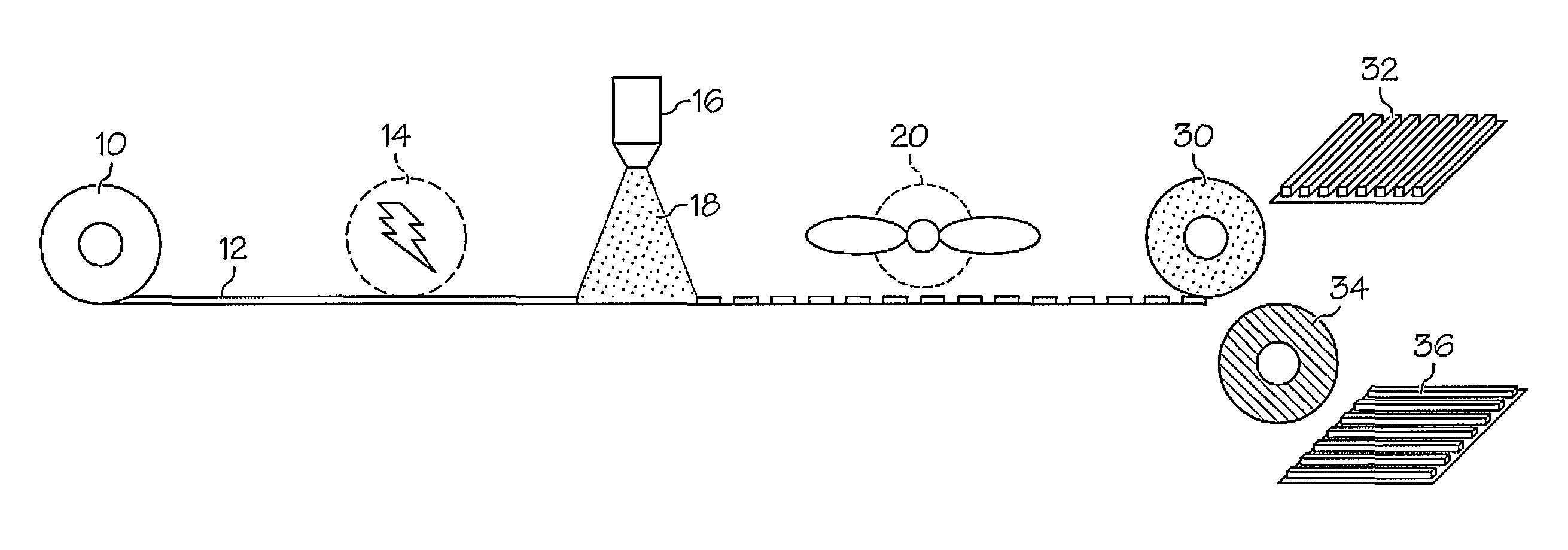Method of forming layered-open-network polishing pads
a technology of open-network and polishing pads, which is applied in the field of polishing pads, can solve the problems of cmp operation being often scratched, gouging or scratching of the wafer, and chatter marks
- Summary
- Abstract
- Description
- Claims
- Application Information
AI Technical Summary
Benefits of technology
Problems solved by technology
Method used
Image
Examples
example 1
[0045]This Example relates to forming an open-network pad through the use of an open network substrate and a photocurable film. First, stretching a woven polyester fiber 205 mesh (75.5 μm) substrate over an aluminum frame at 20 N / m removes any wrinkles from the substrate. Advantageously, a commercial screen printing degreaser washes and degreases the polyester substrate to remove any dirt or stains. This is important because dirt and stains can prevent good contact between the photocurable film and the woven substrate's polyester fibers. The woven substrate was then wet with clean water with sufficient incline to let excess water run down. Then Ulano photocurable film CDF QT50, as delivered attached to its Mylar polyethylene terephthalate protective sheet, was then rolled out with the unprotected side of the photocurable film towards the exterior. The roll was applied on top of the woven substrate and then unrolled downwards with application of some moderate pressure. This pressure,...
example 2
[0046]This Example relates to forming an open-network pad through the use of adhesive to form an open network substrate. In particular, the method builds up a structured pad by gluing the photocurable polymer film to a woven mesh substrate. A woven polyester fiber 305 mesh (56.6 μm) stretched on an aluminum frame between 15 and 20 N / m removed any wrinkles from the substrate. A commercial screen printing degreaser washed and degreased the polyester substrate to remove dirt and stains. This cleaning step facilitated contact and subsequent adhesion between the woven mesh and the photocurable film. An Ulano CDF QT50 photocurable film (about 60 μm thick) was then placed on top of the woven substrate with edges taped to the polyester woven substrate or to the aluminum frame. A precaution was to tape the rest of the woven substrate to avoid spillage from the next step. The next step was to apply some photoemulsion to one side of the mesh. The photoemulsion puddle was then squeegeed from to...
example 3
[0047]The preparation of the base layer using SaatiChem Thik Film photocurable film of about 100 μm thick was realized as described in Example No. 2 with an exposure time of 120 seconds. The addition of subsequent layers of the photocurable film was done through multiple steps. First, the lamination of the second photocurable film layer required wetting the interface between the photocurable film and the second layer. The most important aspect was to achieve uniform water absorption at the surface of the second photocurable film.
[0048]Water spraying did not provide good enough results, but complete immersion of the photocurable film for an 8 to 10 seconds period in water provided uniform wetting and sufficient absorption for a uniform adhesion of the second photocurable layer. After this wet lamination, the assembly (woven mesh on frame plus two layers) was dried for an hour at 35° C. The protective Mylar polyethylene terephthalate sheet of the second layer was then peeled off and t...
PUM
| Property | Measurement | Unit |
|---|---|---|
| temperatures | aaaaa | aaaaa |
| distance | aaaaa | aaaaa |
| rotation angle | aaaaa | aaaaa |
Abstract
Description
Claims
Application Information
 Login to View More
Login to View More - R&D
- Intellectual Property
- Life Sciences
- Materials
- Tech Scout
- Unparalleled Data Quality
- Higher Quality Content
- 60% Fewer Hallucinations
Browse by: Latest US Patents, China's latest patents, Technical Efficacy Thesaurus, Application Domain, Technology Topic, Popular Technical Reports.
© 2025 PatSnap. All rights reserved.Legal|Privacy policy|Modern Slavery Act Transparency Statement|Sitemap|About US| Contact US: help@patsnap.com



